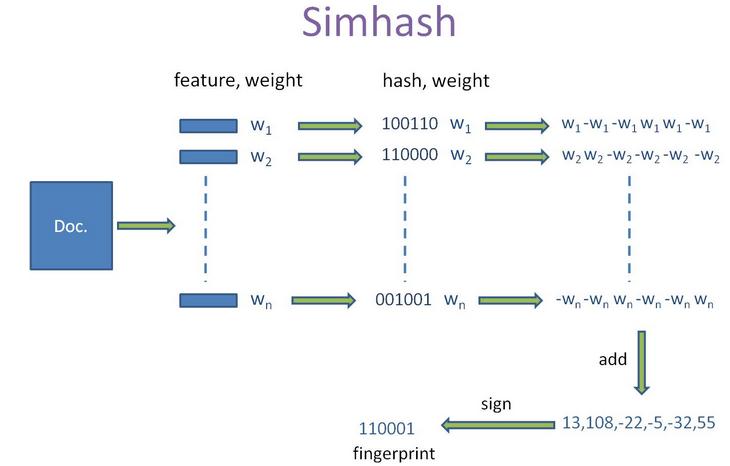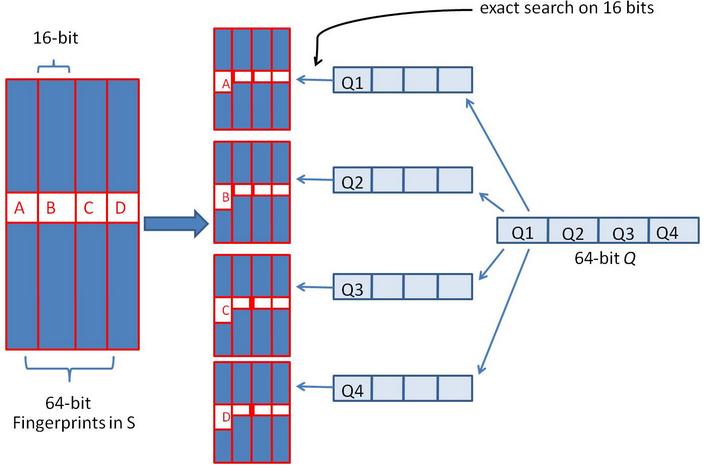傳統(tǒng)的hash 算法只負(fù)責(zé)將原始內(nèi)容盡量均勻隨機(jī)地映射為一個(gè)簽名值,原理上相當(dāng)于偽隨機(jī)數(shù)產(chǎn)生算法。產(chǎn)生的兩個(gè)簽名,如果相等,說(shuō)明原始內(nèi)容在一定概 率 下是相等的;如果不相等,除了說(shuō)明原始內(nèi)容不相等外,不再提供任何信息,因?yàn)榧词乖純?nèi)容只相差一個(gè)字節(jié),所產(chǎn)生的簽名也很可能差別極大。從這個(gè)意義 上來(lái) 說(shuō),要設(shè)計(jì)一個(gè) hash 算法,對(duì)相似的內(nèi)容產(chǎn)生的簽名也相近,是更為艱難的任務(wù),因?yàn)樗暮灻党颂峁┰純?nèi)容是否相等的信息外,還能額外提供不相等的 原始內(nèi)容的差異程度的信息。
而Google 的 simhash 算法產(chǎn)生的簽名,可以用來(lái)比較原始內(nèi)容的相似度時(shí),便很想了解這種神奇的算法的原理。出人意料,這個(gè)算法并不深?yuàn)W,其思想是非常清澈美妙的。
Simhash算法
simhash算法的輸入是一個(gè)向量,輸出是一個(gè) f 位的簽名值。為了陳述方便,假設(shè)輸入的是一個(gè)文檔的特征集合,每個(gè)特征有一定的權(quán)重。比如特征可以是文檔中的詞,其權(quán)重可以是這個(gè)詞出現(xiàn)的次數(shù)。 simhash 算法如下:
1,將一個(gè) f 維的向量 V 初始化為 0 ; f 位的二進(jìn)制數(shù) S 初始化為 0 ;
2,對(duì)每一個(gè)特征:用傳統(tǒng)的 hash 算法對(duì)該特征產(chǎn)生一個(gè) f 位的簽名 b 。對(duì) i=1 到 f :
如果b 的第 i 位為 1 ,則 V 的第 i 個(gè)元素加上該特征的權(quán)重;
否則,V 的第 i 個(gè)元素減去該特征的權(quán)重。
3,如果 V 的第 i 個(gè)元素大于 0 ,則 S 的第 i 位為 1 ,否則為 0 ;
4,輸出 S 作為簽名。


![]()
![]()
算法幾何意義和原理
這個(gè)算法的幾何意義非常明了。它首先將每一個(gè)特征映射為f 維空間的一個(gè)向量,這個(gè)映射規(guī)則具體是怎樣并不重要,只要對(duì)很多不同的特征來(lái)說(shuō),它們對(duì)所對(duì)應(yīng)的 向量是均勻隨機(jī)分布的,并且對(duì)相同的特征來(lái)說(shuō)對(duì)應(yīng)的向量是唯一的就行。比如一個(gè)特征的 4 位 hash 簽名的二進(jìn)制表示為 1010 ,那么這個(gè)特征對(duì)應(yīng)的 4 維向量就是 (1, -1, 1, -1) T ,即hash 簽名的某一位為 1 ,映射到的向量的對(duì)應(yīng)位就為 1 ,否則為 -1 。然后,將一個(gè)文檔中所包含的各個(gè)特征對(duì)應(yīng)的向量加權(quán)求和, 加權(quán)的系數(shù)等于該特征的權(quán)重。
得到的和向量即表征了這個(gè)文檔,我們可以用向量之間的夾角來(lái)衡量對(duì)應(yīng)文檔之間的相似度。最后,為了得到一個(gè) f 位的簽名,需要 進(jìn)一步將其壓縮,如果和向量的某一維大于 0 ,則最終簽名的對(duì)應(yīng)位為 1 ,否則為 0 。這樣的壓縮相當(dāng)于只留下了和向量所在的象限這個(gè)信息,而 64 位的簽名可以 表示多達(dá) 2 64 個(gè)象限,因此只保存所在象限的信息也足夠表征一個(gè)文檔了。
比較相似度
海明距離: 兩個(gè)碼字的對(duì)應(yīng)比特取值不同的比特?cái)?shù)稱(chēng)為這兩個(gè)碼字的海明距離。一個(gè)有效編碼集中, 任意兩個(gè)碼字的海明距離的最小值稱(chēng)為該編碼集的海明距離。舉例如下: 10101 和 00110 從第一位開(kāi)始依次有第一位、第四、第五位不同,則海明距離為 3.
異或: 只有在兩個(gè)比較的位不同時(shí)其結(jié)果是1 ,否則結(jié)果為 0
對(duì)每篇文檔根據(jù)SimHash 算出簽名后,再計(jì)算兩個(gè)簽名的海明距離(兩個(gè)二進(jìn)制異或后 1 的個(gè)數(shù))即可。根據(jù)經(jīng)驗(yàn)值,對(duì) 64 位的 SimHash ,海明距離在 3 以?xún)?nèi)的可以認(rèn)為相似度比較高。
假設(shè)對(duì)64 位的 SimHash ,我們要找海明距離在 3 以?xún)?nèi)的所有簽名。我們可以把 64 位的二進(jìn)制簽名均分成 4 塊,每塊 16 位。根據(jù)鴿巢原理(也成抽屜原理,見(jiàn)組合數(shù)學(xué)),如果兩個(gè)簽名的海明距離在 3 以?xún)?nèi),它們必有一塊完全相同。
我們把上面分成的4 塊中的每一個(gè)塊分別作為前 16 位來(lái)進(jìn)行查找。 建立倒排索引。
![]()
![]()

如果庫(kù)中有2^34 個(gè)(大概 10 億)簽名,那么匹配上每個(gè)塊的結(jié)果最多有 2^(34-16)=262144 個(gè)候選結(jié)果 (假設(shè)數(shù)據(jù)是均勻分布, 16 位的數(shù)據(jù),產(chǎn)生的像限為 2^16 個(gè),則平均每個(gè)像限分布的文檔數(shù)則 2^34/2^16 = 2^(34-16)) ,四個(gè)塊返回的總結(jié)果數(shù)為 4* 262144 (大概 100 萬(wàn))。原本需要比較 10 億次,經(jīng)過(guò)索引,大概就只需要處理 100 萬(wàn)次了。由此可見(jiàn),確實(shí)大大減少了計(jì)算量。
Java 代碼實(shí)現(xiàn):
Java代碼

- package com.gemantic.nlp.commons.simhash;
-
- import java.math.BigInteger;
- import java.util.ArrayList;
- import java.util.List;
- import java.util.StringTokenizer;
-
- public class SimHash {
-
- private String tokens;
-
- private BigInteger intSimHash;
-
- private String strSimHash;
-
- private int hashbits = 64;
-
- public SimHash(String tokens) {
- this.tokens = tokens;
- this.intSimHash = this.simHash();
- }
-
- public SimHash(String tokens, int hashbits) {
- this.tokens = tokens;
- this.hashbits = hashbits;
- this.intSimHash = this.simHash();
- }
-
- public BigInteger simHash() {
- int[] v = new int[this.hashbits];
- StringTokenizer stringTokens = new StringTokenizer(this.tokens);
- while (stringTokens.hasMoreTokens()) {
- String temp = stringTokens.nextToken();
- BigInteger t = this.hash(temp);
- for (int i = 0; i < this.hashbits; i++) {
- BigInteger bitmask = new BigInteger("1").shiftLeft(i);
- if (t.and(bitmask).signum() != 0) {
- v[i] += 1;
- } else {
- v[i] -= 1;
- }
- }
- }
- BigInteger fingerprint = new BigInteger("0");
- StringBuffer simHashBuffer = new StringBuffer();
- for (int i = 0; i < this.hashbits; i++) {
- if (v[i] >= 0) {
- fingerprint = fingerprint.add(new BigInteger("1").shiftLeft(i));
- simHashBuffer.append("1");
- }else{
- simHashBuffer.append("0");
- }
- }
- this.strSimHash = simHashBuffer.toString();
- System.out.println(this.strSimHash + " length " + this.strSimHash.length());
- return fingerprint;
- }
-
- private BigInteger hash(String source) {
- if (source == null || source.length() == 0) {
- return new BigInteger("0");
- } else {
- char[] sourceArray = source.toCharArray();
- BigInteger x = BigInteger.valueOf(((long) sourceArray[0]) << 7);
- BigInteger m = new BigInteger("1000003");
- BigInteger mask = new BigInteger("2").pow(this.hashbits).subtract(
- new BigInteger("1"));
- for (char item : sourceArray) {
- BigInteger temp = BigInteger.valueOf((long) item);
- x = x.multiply(m).xor(temp).and(mask);
- }
- x = x.xor(new BigInteger(String.valueOf(source.length())));
- if (x.equals(new BigInteger("-1"))) {
- x = new BigInteger("-2");
- }
- return x;
- }
- }
-
- /**
- * 取兩個(gè)二進(jìn)制的異或,統(tǒng)計(jì)為1的個(gè)數(shù),就是海明距離
- * @param other
- * @return
- */
-
- public int hammingDistance(SimHash other) {
-
- BigInteger x = this.intSimHash.xor(other.intSimHash);
- int tot = 0;
-
- //統(tǒng)計(jì)x中二進(jìn)制位數(shù)為1的個(gè)數(shù)
- //我們想想,一個(gè)二進(jìn)制數(shù)減去1,那么,從最后那個(gè)1(包括那個(gè)1)后面的數(shù)字全都反了,對(duì)吧,然后,n&(n-1)就相當(dāng)于把后面的數(shù)字清0,
- //我們看n能做多少次這樣的操作就OK了。
-
- while (x.signum() != 0) {
- tot += 1;
- x = x.and(x.subtract(new BigInteger("1")));
- }
- return tot;
- }
-
- /**
- * calculate Hamming Distance between two strings
- * 二進(jìn)制怕有錯(cuò),當(dāng)成字符串,作一個(gè),比較下結(jié)果
- * @author
- * @param str1 the 1st string
- * @param str2 the 2nd string
- * @return Hamming Distance between str1 and str2
- */
- public int getDistance(String str1, String str2) {
- int distance;
- if (str1.length() != str2.length()) {
- distance = -1;
- } else {
- distance = 0;
- for (int i = 0; i < str1.length(); i++) {
- if (str1.charAt(i) != str2.charAt(i)) {
- distance++;
- }
- }
- }
- return distance;
- }
-
- /**
- * 如果海明距離取3,則分成四塊,并得到每一塊的bigInteger值 ,作為索引值使用
- * @param simHash
- * @param distance
- * @return
- */
- public List<BigInteger> subByDistance(SimHash simHash, int distance){
- int numEach = this.hashbits/(distance+1);
- List<BigInteger> characters = new ArrayList();
-
- StringBuffer buffer = new StringBuffer();
-
- int k = 0;
- for( int i = 0; i < this.intSimHash.bitLength(); i++){
- boolean sr = simHash.intSimHash.testBit(i);
-
- if(sr){
- buffer.append("1");
- }
- else{
- buffer.append("0");
- }
-
- if( (i+1)%numEach == 0 ){
- BigInteger eachValue = new BigInteger(buffer.toString(),2);
- System.out.println("----" +eachValue );
- buffer.delete(0, buffer.length());
- characters.add(eachValue);
- }
- }
-
- return characters;
- }
-
- public static void main(String[] args) {
- String s = "This is a test string for testing";
-
- SimHash hash1 = new SimHash(s, 64);
- System.out.println(hash1.intSimHash + " " + hash1.intSimHash.bitLength());
-
- hash1.subByDistance(hash1, 3);
-
- System.out.println("\n");
- s = "This is a test string for testing, This is a test string for testing abcdef";
- SimHash hash2 = new SimHash(s, 64);
- System.out.println(hash2.intSimHash+ " " + hash2.intSimHash.bitCount());
- hash1.subByDistance(hash2, 3);
- s = "This is a test string for testing als";
- SimHash hash3 = new SimHash(s, 64);
- System.out.println(hash3.intSimHash+ " " + hash3.intSimHash.bitCount());
- hash1.subByDistance(hash3, 3);
- System.out.println("============================");
- int dis = hash1.getDistance(hash1.strSimHash,hash2.strSimHash);
-
- System.out.println(hash1.hammingDistance(hash2) + " "+ dis);
-
- int dis2 = hash1.getDistance(hash1.strSimHash,hash3.strSimHash);
-
- System.out.println(hash1.hammingDistance(hash3) + " " + dis2);
-
-
-
- }
- }
參考: http://blog.sina.com.cn/s/blog_72995dcc010145ti.html
http://blog.sina.com.cn/s/blog_56d8ea900100y41b.html
http://blog.csdn.net/meijia_tts/article/details/7928579
posted on 2015-04-17 14:43
SIMONE 閱讀(741)
評(píng)論(0) 編輯 收藏 所屬分類(lèi):
JAVA